

 |
Search the Site with

|
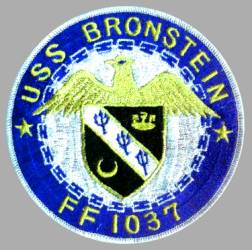 | 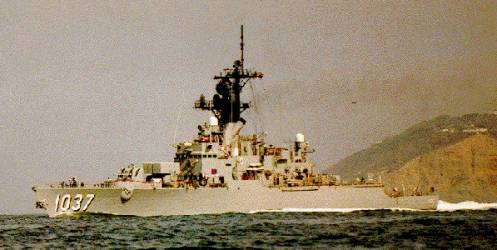 |
USS BRONSTEIN was the lead ship of the Navy's third class of escort vessels built after World War II. Additionally, the two BRONSTEIN - class ships were the Navy's first escort vessels equipped with the SQS-26 Sonar and with the ASROC missile launchers.
Decommissioned on December 13, 1990, and stricken from the Navy list on October 4, 1991, the BRONSTEIN was sold to Mexico where she was recommissioned as HERMENEGILDO GALEANA.
USS BRONSTEIN's awards include the Combat Action Ribbon, the Navy Unit Commendation Ribbon, the Meritorious Unit Commendation Ribbon, the Navy E Ribbon, the National Defense Service Ribbon, the Armed Forces Expeditionary Ribbon, the Vietnam Service Medal, the Humanitarian Service Medal, the Sea Service Deployment Ribbon, the Republic of Vietnam Campaign Ribbon and the Coast Guard Special Operations Ribbon.
| General Characteristics: | Awarded: June 13, 1960 |
| Keel laid: May 16, 1961 | |
| Launched: March 31, 1962 | |
| Commissioned: June 16, 1963 | |
| Decommissioned: December 13, 1990 | |
| Builder: Avondale Shipyards, New Orleans, La. | |
| Propulsion system: 2 Foster-Wheeler boilers; 1 Westinghouse geared turbine; 35,000shp; 1 shaft | |
| Length: 371.4 feet (113.2 meters) | |
| Beam: 40.4 feet (12.3 meters) | |
| Draft: 23 feet (7 meters) | |
| Displacement: approx. 2,650 tons full load | |
| Speed: 26 knots | |
| Armament: one Mk-16 missile launcher for ASROC missiles, two Mk-33 3-inch/50 caliber guns (one mount), | |
| Aircraft: none | |
| Crew: 16 officers, 183 enlisted |
Crew List:
This section contains the names of sailors who served aboard USS BRONSTEIN. It is no official listing but contains the names of sailors who submitted their information.
About the Ship's Coat of Arms:
 The BRONSTEIN plaque is in the form of a coat of arms which is indicative of its lineage. To understand the plaque, one must know a little of the ship's history. FF 1037 is the second ship to bear the name of BRONSTEIN. The first BRONSTEIN, named after Ben Richard BRONSTEIN, established a striking record in ASW by engaging and sinking 3 German submarines and severely damaging a fourth, thereby gaining a Presidential Unit Citation.
The BRONSTEIN plaque is in the form of a coat of arms which is indicative of its lineage. To understand the plaque, one must know a little of the ship's history. FF 1037 is the second ship to bear the name of BRONSTEIN. The first BRONSTEIN, named after Ben Richard BRONSTEIN, established a striking record in ASW by engaging and sinking 3 German submarines and severely damaging a fourth, thereby gaining a Presidential Unit Citation.
The present plaque reflects these past achievements. The eagle atop the shield marks her as a war ship of the U.S. Navy. The crescent with the horns pointing upward alludes to the heritage of a preceding BRONSTEIN. On the right hand field of the shield is the naval crown. This crown consists of a circlet on which is mounted the stems and sails of ships alternately. The naval crown was characteristically bestowed on men who distinguished themselves in a career of naval service - such as Lord Nelson. In this instance, the naval crown refers to the outstanding record of the first BRONSTEIN in WWII. The tridents on the diagonal band across the shield are symbolic of sea power and a ship of war.
About the Ship's Name:
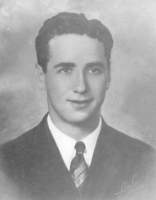 Ben Richard Bronstein - born on 14 April 1915 in Manchester, N.H. - graduated from the University of New Hampshire in 1936 and from Tufts College Medical School at Boston in 1940. Dr. Bronstein was appointed Assistant Surgeon with the rank of lieutenant (junior grade) on 4 October 1941. He reported to the Portsmouth (N.H.) Navy Yard on 6 November; then moved on to Casco Bay, Maine, to await transportation to Argentia, Newfoundland, to meet JACOB JONES (DD 130). He reported on board that destroyer late in December.
Ben Richard Bronstein - born on 14 April 1915 in Manchester, N.H. - graduated from the University of New Hampshire in 1936 and from Tufts College Medical School at Boston in 1940. Dr. Bronstein was appointed Assistant Surgeon with the rank of lieutenant (junior grade) on 4 October 1941. He reported to the Portsmouth (N.H.) Navy Yard on 6 November; then moved on to Casco Bay, Maine, to await transportation to Argentia, Newfoundland, to meet JACOB JONES (DD 130). He reported on board that destroyer late in December.
While serving as a roving antisubmarine patrol ship off the Delaware Capes on 27 February 1942, JACOB JONES spotted the burning wreckage of the torpedoed tanker R. P. RESOR. The destroyer searched the area around the wreckage for survivors and then headed south on patrol. At dawn on 28 February, the undetected German submarine U-578 sank JACOB JONES with at least two torpedoes. Lt.(jg.) Bronstein was lost with the ship.
USS BRONSTEIN History:
USS BRONSTEIN, the second ship to bear the name, was commissioned as a Destroyer Escort (DE) on 15 June 1963. It was the first ship of a two ship class built by the Avondale Shipyards, Inc., in Westwego; Louisiana. As originally configured, BRONSTEIN was armed with two 3 inch rapid fire (dual gun) mounts, a Drone (Remote Controlled) Anti-Submarine Helicopter (DASH), and Anti-Submarine Surface Launched torpedoes. Most importantly, BRONSTEIN was the prototype for a new generation of Anti-Submarine Warfare (ASW) ocean escort with a large bow-mounted sonar (AN/SQS-26 AXR) and Anti-Submarine Rocket (ASROC) launcher mounted forward of the bridge.
Following a Panama Canal transit, FF 1037 was homeported in San Diego for the next five years. Operations were generally confined to the Eastern Pacific until January 1966 when she made her first Western Pacific (WESTPAC) deployment with ASW GROUP 3. Her second deployment was completed in 1967. BRONSTEIN then went into Long Beach Naval Shipyard for overhaul in February 1968. Upon completion the ship remained homeported in Long Beach until 1972.
In September of 1972 BRONSTEIN returned to the rigors of WESTPAC, working with the carriers USS AMERICA (CV 66) and USS MIDWAY (CV 41) in the Western Pacific and South China Sea. In December of that year the ship was directed to proceed immediately to the Gulf of Tonkin to assume duties as Gunline Command Ship. While on the gunline, BRONSTEIN fired her guns at an enemy for the first time and also received hostile fire in return. Her Vietnam War duties concluded in March 1973 when she returned to San Diego.
A 1973 overhaul was extensive, with the removal of the aft gun mount. Installed in its place was a state of the art passive long range sonar device, the Towed Anti-Submarine Surveillance (TASS) System. It had more than 6000 ft of coaxial cable and hydrophones to be streamed from the fantail to allow for passive (listen only) sonar operation.
With an enhanced sonar and anti-submarine capability, BRONSTEIN deployed again in November 1973 with the aircraft carrier USS KITTY HAWK (CV 63). Another WESTPAC in 1975 was followed by a regular overhaul in 1976. During this period, the ship was redesignated a "Fast Frigate" (FF) during a general reclassification of all the Navy's cruiser-destroyer units. The next several years were spent in local operations and deployments to WESTPAC with the last deployment completed in April 1984. During this time frame, the TASS was removed from the ship.
Subsequently, BRONSTEIN - a member of Destroyer Squadron 33 - operated extensively in the Eastern Pacific conducting ASW operations, fleet support missions, and assisting the U.S. Coast guard in Law Enforcement and drug interdiction operations.
BRONSTEIN was selected by the Chief of Naval Operations as the test and evaluation platform for the Defense Department's advanced Extremely High Frequency Satellite Communication System. EHF SATCOM was designed to support joint service operations well into the 21st century.
The installation was completed in June 1989 in time for BRONSTEIN's 26th birthday. At that time she was both the oldest fast frigate in the fleet and the only one equipped with the military's newest satellite communications system.
USS BRONSTEIN was decommissioned 13 December 1990.
USS BRONSTEIN's Commanding Officers:
| Period | Name |
|---|---|
| June 15, 1963 - July 18, 1964 | LCDR Stanley T. Counts, USN |
| July 18, 1964 - November 13, 1965 | LCDR William R. Smedberg, IV, USN |
| November 13, 1965 - May 2, 1967 | LCDR Robert L. Lage, USN |
| May 2, 1967 - December 13, 1968 | LCDR John Watson, USN |
| December 13, 1968 - June 30, 1970 | LCDR Walter D. Bonhag, Jr., USN |
| June 30, 1970 - April 22, 1971 | LCDR Edward B. Baker, USN |
| April 22, 1971 - May 24, 1971 | LCDR Kenneth F. Robinson, USN |
| May 24, 1971 - September 6, 1972 | LCDR Charles D. Ewing, USN |
| September 6, 1972 - December 17, 1973 | LCDR Glenn E. Whisler, USN |
| December 17, 1973 - April 18, 1975 | LCDR Marvel H. Loy, USN |
| April 18, 1975 - December 15, 1976 | LCDR William J. Flanagan, USN |
| December 15, 1976 - December 2, 1978 | LCDR Larry R. Seaquist, USN |
| December 2, 1978 - December 5, 1980 | LCDR William R. Schmidt, USN |
| December 5, 1980 - February 25, 1983 | LCDR James C. Dawson, Jr., USN |
| February 25, 1983 - January 4, 1985 | LCDR Neil F. Byrne, USN |
| January 4, 1985 - May 15, 1987 | LCDR David T. Hart, Jr., USN |
| May 15, 1987 - May 12, 1989 | LCDR Richard L. Wright, USN |
| May 12, 1989 - December 13, 1990 | LCDR Scott L. Jones, USN |
USS BRONSTEIN Image Gallery:
 | 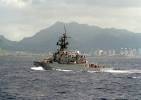 | 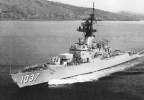 | 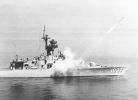 | 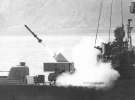 |
The photo below is an official US Navy photo taken on June 1, 1991. It shows the BRONSTEIN at the Pearl Harbor Naval Inactive Ship Maintenance Facility.
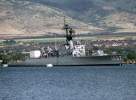 |
 Back to Frigates List.
Back to Frigates List.  Back to Ships List.
Back to Ships List.  Back to selection page.
Back to selection page.  Back to 1st page.
Back to 1st page.